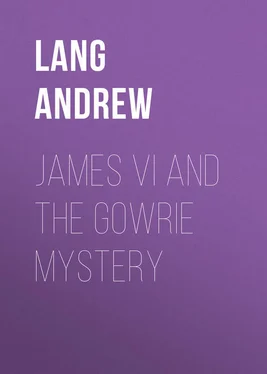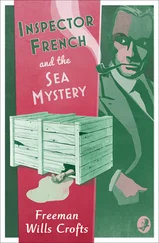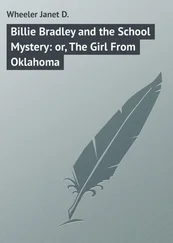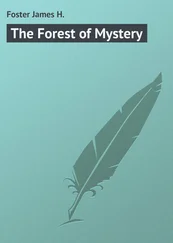Andrew Lang - James VI and the Gowrie Mystery
Здесь есть возможность читать онлайн «Andrew Lang - James VI and the Gowrie Mystery» — ознакомительный отрывок электронной книги совершенно бесплатно, а после прочтения отрывка купить полную версию. В некоторых случаях можно слушать аудио, скачать через торрент в формате fb2 и присутствует краткое содержание. Жанр: foreign_antique, foreign_prose, на английском языке. Описание произведения, (предисловие) а так же отзывы посетителей доступны на портале библиотеки ЛибКат.
- Название:James VI and the Gowrie Mystery
- Автор:
- Жанр:
- Год:неизвестен
- ISBN:нет данных
- Рейтинг книги:5 / 5. Голосов: 1
-
Избранное:Добавить в избранное
- Отзывы:
-
Ваша оценка:
- 100
- 1
- 2
- 3
- 4
- 5
James VI and the Gowrie Mystery: краткое содержание, описание и аннотация
Предлагаем к чтению аннотацию, описание, краткое содержание или предисловие (зависит от того, что написал сам автор книги «James VI and the Gowrie Mystery»). Если вы не нашли необходимую информацию о книге — напишите в комментариях, мы постараемся отыскать её.
James VI and the Gowrie Mystery — читать онлайн ознакомительный отрывок
Ниже представлен текст книги, разбитый по страницам. Система сохранения места последней прочитанной страницы, позволяет с удобством читать онлайн бесплатно книгу «James VI and the Gowrie Mystery», без необходимости каждый раз заново искать на чём Вы остановились. Поставьте закладку, и сможете в любой момент перейти на страницу, на которой закончили чтение.
Интервал:
Закладка:
As to the interior, entering the main doorway you found yourself in the hall. A door led thence into a smaller dining-room on the left. The hall itself had a door and external stair giving on the garden behind. The chief staircase, which you entered from the hall, led to the Great Gallery, built and decorated by the late Earl. This extended above the dining-room and the hall, and, to the right, was separated by a partition and a door from the large upstairs room on the same flat called ‘The Gallery Chamber.’ At the extremity of this chamber, on the left hand as you advanced, was a door leading into a ‘round,’ or turret, or little circular-shaped ‘study,’ of which one window seems to have looked to the gateway, the other to the street. People below in the street could see a man looking out of the turret window. A door in the gallery chamber gave on the narrow staircase called ‘The Black Turnpike,’ by which the upper floor might be reached by any one from the quadrangle, without entering the main door, and going up the broad chief staircase. Thus, to quote a poet who wrote while Gowrie House was extant (in 1638):
The Palace kythes, may nam’d be Perth’s White Hall
With orchards like these of Hesperides.
The palace was destroyed, to furnish a site for a gaol and county buildings, in 1807, but the most interesting parts had long been in ruins. 7 7 The description is taken from diagrams in Pitcairn, derived from a local volume of Antiquarian Proceedings. See, too, The Muses’ Threnodie , by H. Adamson, 1638, with notes by James Cant (Perth, 1774), pp. 163, 164.
In 1774, an antiquary, Mr. Cant, writes that the palace, after the Forty Five, was converted into artillery barracks. ‘We see nothing but the remains of its former grandeur.’ The coats of arms of ‘the nobility and gentlemen of fortune,’ who dwelt in Spey Gate and Water Gate, were, in 1774, still visible on the walls of their houses. A fragment of the old palace is said to exist to-day in the Gowrie Inn. Into this palace the King was led by Gowrie: he was taken to the dining chamber on the left of the great hall; in the hall itself Lennox, Mar, and the rest of the retinue waited and wearied, for apparently no dinner had been provided, and even a drink for his thirsty Majesty was long in coming. Gowrie and the Master kept going in and out, servants were whispered to, and Sir Thomas Erskine sent a townsman to buy him a pair of green silk stockings in Perth. 8 8 Pitcairn, ii. 199.
He wanted to dine comfortably.
Leaving the King’s retinue in the hall, and the King in the dining chamber off the hall, we may note what, up to this point, the nobles and gentlemen of the suite had to say, at the trial in November, about the adventures of that August morning. Mar had not seen the Master at Falkland; after the kill Mar did not succeed in rejoining James till they were within two or three miles of Perth.
Drummond of Inchaffray had nodded to the Master, at Falkland, before the Master met the King at the stables. He later saw the Master in conference for about a quarter of an hour with James, outside the stables. The Master then left the King: Inchaffray invited him to breakfast, but he declined, ‘as his Majesty had ordered him to wait upon him.’ (According to other evidence he had already breakfasted at Falkland.) Inchaffray then breakfasted in Falkland town, and next rode along the highway towards his own house. On the road he overtook Lennox, Lindores, Urchill, Hamilton of Grange, Finlay Taylor, the King, and the Master, riding Perthwards. He joined them, and went with them into Gowrie House.
Nobody else, among the witnesses, did anything but agree with Lennox’s account up to this point. But four menials of James, for example, a cellarer and a porter, were at Gowrie House, in addition to the nobles and gentlemen who gave this evidence.
To return to Lennox’s tale: dinner was not ready for his hungry Majesty, as we have said, till an hour after his arrival; was not ready, indeed, till about two o’clock. He had obviously not been expected, or Gowrie did not wish it to be known that he was expected, and himself had dined before the King’s arrival, between twelve and one o’clock. A shoulder of mutton, a fowl, and a solitary grouse were all that the Earl’s caterer could procure, except cold meat: obviously a poor repast to set before a king. It is said that the Earl had meant to leave Perth in the afternoon. When James reached the stage of dessert, Gowrie, who had waited on him, entered the hall, and invited the suite to dine. When they had nearly finished, Gowrie returned to them in the hall, and sent round a grace-cup, in which all pledged the King. Lennox then rose, to rejoin the King (who now passed, with the Master, across and out of the hall), but Gowrie said ‘His Majesty was gone upstairs quietly some quiet errand.’ Gowrie then called for the key of the garden, on the banks of the Tay, and he, Lindores, the lame Dr. Herries, and others went into the garden, where, one of them tells us, they ate cherries. While they were thus engaged, Gowrie’s equerry, or master stabler, a Mr. Thomas Cranstoun, who had been long in France, and had returned thence with the Earl in April, appeared, crying, ‘The King has mounted, and is riding through the Inch,’ that is, the Inch of Perth, where the famous clan battle of thirty men a side had been fought centuries ago. Gowrie shouted ‘Horses! horses!’ but Cranstoun said ‘Your horse is at Scone,’ some two miles off, on the further side of the Tay. Why the Earl that day kept his horse so remote, in times when men of his rank seldom walked, we may conjecture later (cf. p. 86, infra ).
The Earl, however (says Lennox), affected not to hear Cranstoun, and still shouted ‘Horses!’ He and Lennox then passed into the house, through to the front yard, or Close, and so to the outer gate, giving on the street. Here Lennox asked the porter, Christie, if the King had gone. The porter said he was certain that the King had not left the house. On this point Lindores, who had been with Gowrie and Lennox in the garden, and accompanied them to the gate, added (as indeed Lennox also did) that Gowrie now explained to the porter that James had departed by the back gate. ‘That cannot be, my Lord,’ said the porter, ‘for I have the key of the back gate.’ Andrew Ray, a bailie of Perth, who had been in the house, looking on, told the same tale, adding that Gowrie gave the porter the lie. The porter corroborated all this at the trial, and quoted his own speech about the key, as it was given by Lindores. He had the keys, and must know whether the King had ridden away or not.
In this odd uncertainty, Gowrie said to Lennox, ‘I am sure the King has gone; but stay, I shall go upstairs, and get your lordship the very certainty.’ Gowrie thereon went from the street door, through the court, and up the chief staircase of the house, whence he came down again at once, and anew affirmed to Lennox that ‘the King was forth at the back gate and away.’ They all then went out of the front gate, and stood in the street there, talking, and wondering where they should seek for his Majesty.
Where was the King? Here we note a circumstance truly surprising. It never occurred to the Earl of Gowrie, when dubiously told that the King had ‘loupen on’ – and ridden off – to ask, Where is the King’s horse ? If the Royal nag was in the Earl’s stable, then James had not departed. Again – a thing more astonishing still – it has never occurred to any of the unnumbered writers on the Gowrie conspiracy to ask, ‘How did the Earl, if guilty of falsehood as to the King’s departure, mean to get over the difficulty about the King’s horse?’ If the horse was in the stable, then the King had not ridden away, as the Earl declared. Gowrie does not seem to have kidnapped the horse. We do not hear, from the King, or any one, that the horse was missing when the Royal party at last rode home.
Читать дальшеИнтервал:
Закладка:
Похожие книги на «James VI and the Gowrie Mystery»
Представляем Вашему вниманию похожие книги на «James VI and the Gowrie Mystery» списком для выбора. Мы отобрали схожую по названию и смыслу литературу в надежде предоставить читателям больше вариантов отыскать новые, интересные, ещё непрочитанные произведения.
Обсуждение, отзывы о книге «James VI and the Gowrie Mystery» и просто собственные мнения читателей. Оставьте ваши комментарии, напишите, что Вы думаете о произведении, его смысле или главных героях. Укажите что конкретно понравилось, а что нет, и почему Вы так считаете.
